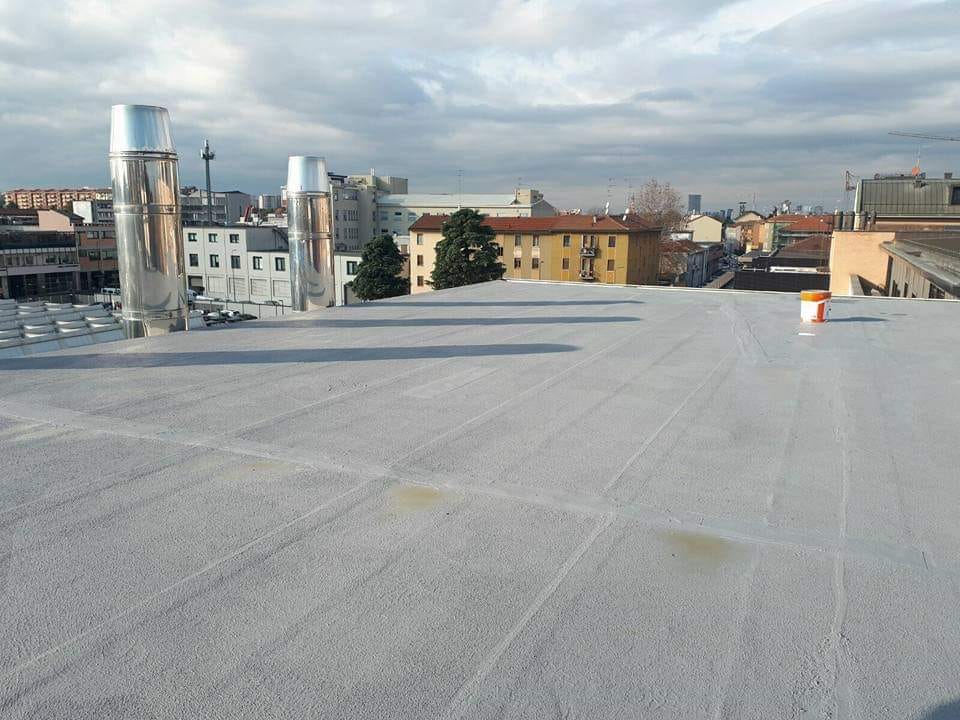
Among the best products that we can use to repair damaged bituminous membranes (and protected them afterwards), there are adhesive sealants without solvents, levelling pastes, water-based bituminous membranes and liquid membranes that reflect sun rays.
The waterproofing action of bituminous membranes on flat roofs can be compromised by several factors, some of which are described hereafter. These surfaces are subject to thermal excursions (freeze-thaw cycles), to the action of bad weather (rain, wind), of U.V. and to mechanical stresses. All these elements contribute to reduce the effect of the waterproofing material’ seal, compromising the nature of the coating. This, in turn, can lead to the creation of cracks and fractures, thus facilitating the damaging action of the water.

Critical areas of bituminous membranes
When waterproofing using torched- down bituminous membranes, butt and side welds are generally considered the most critical and vulnerable areas. It is also necessary to consider the action of stagnant water, which contains acidic elements that can corrode the bituminous surface over time. The result is the detachment of some welding and the formation of cracks and holes. If the above happens, the waterproofing loses its uniformity and continuity, and therefore its effectiveness.
Best practices to help prevent damage
Through attentive controls and periodic maintenances of flat roofs it is possible to repair damaged parts of the membranes. Therefore, we can prevent those situations that can damage waterproof coatings. In fact, we can implement different types of interventions that make the surface of flat roofs perfectly waterproofed and protected. This is possible thanks to the modern technology that offers innovative and high-performance solutions for these types of applications. These solutions not only protect the waterproofing function of bituminous membranes, but also restore damaged surfaces.
Actions to implement when repairing damaged bituminous membranes
There are many possible cases of intervention for the repair of damaged bituminous membranes. For example, if it is necessary to regularize and renovate the slopes of bituminous substrates, whether they are composed of smooth or slated bituminous membranes, it is possible to use a ready-to-use one-component levelling paste. This levelling paste is bitumen and water based, it is easily workable and can also be used for the realization of connecting covings on the wall to floor corners of the roof. The use of adhesive sealants based on bitumen and high-quality polymers is recommended for the sealing of overlapping joints in the practice of cold laying of polymer- bitumen membranes.
Modern technologies offer innovative products
The new products available in the market allow to effectively renovate old floors without removing the existing waterproofing. This is a great advantage in terms of time – the removal of the old membranes involves additional work which influences the costs – and in terms of the production of waste materials which must then be disposed of in the appropriate landfills.
In order to cover the old membranes and renew the surface of roofs, nowadays we can use bituminous membranes with highly elastic aqueous emulsions like Winkler One. They resist aging, to cold-hot cycles, and remain unchanged both at low and high temperatures.

When dealing with slated membranes, it is recommended to use special water-based transparent elastomeric liquid membranes (the most advanced techniques in the field of waterproofing do not include solvents), which guarantee maximum protection for the slated bituminous surface.
In fact, in the above-mentioned situation, it is fundamental not to alter the aesthetic appearance of the roof and to prevent and limit the detachment of slate flakes.
Conclusion: let’s implement a “Protection practice”
The innovative waterproofing products’ action is not limited to the protection from water and humidity. They offer performances that bring actual benefits to the economy of buildings.
In repairing bituminous surfaces on flat roofs, some water-based products are restorative and protective, formulated with special fillers and additives that give a high reflectivity to sun rays and high submissiveness in the infrared like Wingum Plus H20 REFLEX. They also provide an excellent resistance to water stagnation. These products keep the surfaces of the roofs fresh, even during the hottest months, with great savings in the cooling costs. Also, if applicable, with a significant increase in the energy of photovoltaic panels.
We can say that this “protection practice” for flat roofs offers specific solutions for all types of problems that can undermine perfect waterproofing. Whether in case of laying new bituminous or liquid membranes, or during renovations of existing surfaces, the same “protection practice” emphasises the preparation of the foundations. Technological advances offer professionals the possibility of designing waterproofing and resurfacing by choosing tailored solutions, with the guarantee of a great result.











